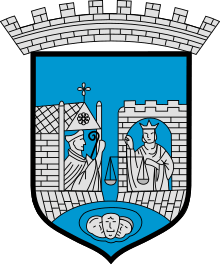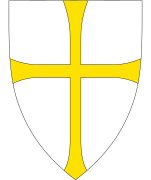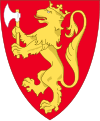Trondheim
| Trondheim | |||
|---|---|---|---|
| City | |||
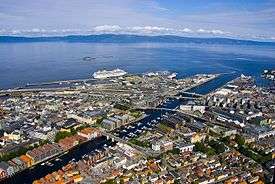  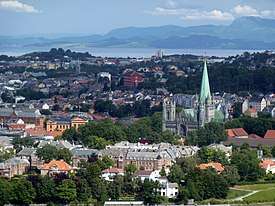   From upper left: Outer city with Nidelva and sea port, Verftsbrua bridge, Trondheim Central Station at Brattøra, Inner city with Nidaros Cathedral, Old Town Bridge with Lykkens portal, Rosenborgbassenget at Nedre Elvehavn | |||
| |||
|
Nickname(s): Stiftstaden (Norwegian: "The diocese city") | |||
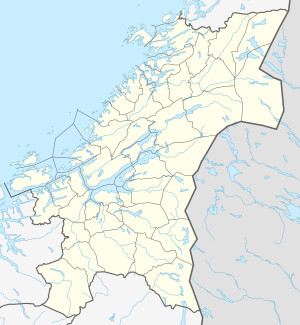 Trondheim 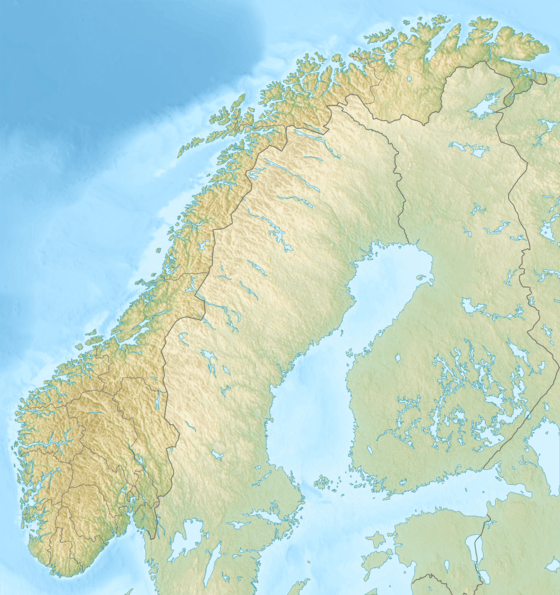 Trondheim | |||
| Coordinates: 63°25′47″N 10°23′36″E / 63.42972°N 10.39333°ECoordinates: 63°25′47″N 10°23′36″E / 63.42972°N 10.39333°E | |||
| Country |
| ||
| Municipality | Trondheim | ||
| County | Trøndelag | ||
| District | Trondheim Region | ||
| Established | 997 | ||
| Government | |||
| • Mayor | Rita Ottervik | ||
| Area | |||
| • City | 321.81 km2 (124.25 sq mi) | ||
| • Urban | 342.30 km2 (132.16 sq mi) | ||
| • Metro | 7,295 km2 (2,817 sq mi) | ||
| Population (2017)[1] | |||
| • City | 190 464[2] | ||
| • Urban | 180 557[3] | ||
| • Metro | 274,958 | ||
| • Metro density | 38/km2 (98/sq mi) | ||
| • Municipality/Urban rank | 3rd/4th | ||
| • Metro rank | 4th | ||
| Demonym(s) |
Trønder[4] Trondheimar Trondheimer | ||
| Time zone | UTC+1 (CET) | ||
| • Summer (DST) | UTC+2 (CEST) | ||
| Website |
www | ||
| Historical population | ||
|---|---|---|
| Year | Pop. | ±% |
| 1769 | 11,315 | — |
| 1951 | 56,582 | +400.1% |
| 1960 | 59,286 | +4.8% |
| 1970 | 126,190 | +112.8% |
| 1980 | 134,726 | +6.8% |
| 1990 | 137,346 | +1.9% |
| 2000 | 148,859 | +8.4% |
| 2010 | 171,540 | +15.2% |
| 2014 | 183,960 | +7.2% |
| Source: Statistics Norway[5][6] | ||
Trondheim (Norwegian pronunciation: [ˈtrɔnhæim]; historically Kaupangen, Nidaros and Trondhjem) is a city and municipality in Trøndelag county, Norway. It has a population of 193,501 (4th quarter 2017), and is the third-most populous municipality in Norway, although the fourth largest urban area. It is the third largest city in the country, with a population (2013) of 169,972 inhabitants within the city borders.[7] Trondheim lies on the south shore of Trondheim Fjord at the mouth of the River Nidelva. The city is dominated by the Norwegian University of Science and Technology (NTNU), the Foundation for Scientific and Industrial Research (SINTEF), St. Olavs University Hospital and other technology-oriented institutions.
The settlement was founded in 997 as a trading post, and it served as the capital of Norway during the Viking Age until 1217. From 1152 to 1537, the city was the seat of the Catholic Archdiocese of Nidaros; since then, it has remained the seat of the Lutheran Diocese of Nidaros and the Nidaros Cathedral. It was incorporated in 1838. The current municipality dates from 1964, when Trondheim merged with Byneset, Leinstrand, Strinda and Tiller.
The city functions as the seat of the County Mayor of Trøndelag county, but not as the administrative centre, which is Steinkjer. This is to make the county more efficient and not too centralized, as Trøndelag is the second largest county in Norway.
Names and etymology

The city was originally given the name by Olav Tryggvason. It was for a long time called Nidaros (English: Mouth of the river Nid), or Niðaróss in the Old Norse spelling. But it was also just called kaupangr ("city") or, more specifically, kaupangr í Þróndheimi ("the city in the district Þróndheimr", i.e. Trøndelag). In the late Middle Ages people started to call the city just Þróndheimr. In the Dano-Norwegian period, during the years as a provincial town in the united kingdoms of Denmark–Norway, the city name was spelled Trondhjem.
Following the example set by the renaming of the capital Kristiania to Oslo, Nidaros was reintroduced as the official name of the city for a brief period from 1 January 1930 until 6 March 1931. The name was restored in order to reaffirm the city's link with its glorious past, despite the fact that a 1928 referendum on the name of the city had resulted in 17,163 votes in favour of Trondhjem and only 1,508 votes in favour of Nidaros.[8] Public outrage later in the same year, even taking the form of riots, forced the Storting to settle for the medieval city name Trondheim. The name of the diocese was, however, changed from Trondhjem stift to Nidaros bispedømme (English: Diocese of Nidaros) in 1918.
Trondheim was briefly named Drontheim during the Second World War, as a German exonym.
Historically, Trondheimen indicates the area around Trondheim Fjord. The spelling Trondhjem was officially rejected, but many still prefer that spelling of the city's name.
History
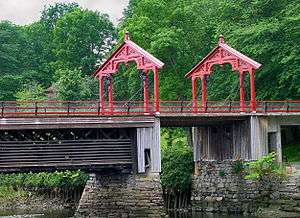
- For the ecclesiastical history, see Archiepiscopate of Nidaros
Trondheim was named Kaupangen (English: market place or trading place) by Viking King Olav Tryggvason in 997. Shortly thereafter it came to be called Nidaros. In the beginning it was frequently used as a military retainer (Old Norse: "hird"-man) of King Olav I. It was frequently used as the seat of the king, and was the capital of Norway until 1217.
People have been living in the region for thousands of years as evidenced by the rock carvings in central Norway, the Nøstvet and Lihult cultures and the Corded Ware culture. In ancient times, the Kings of Norway were hailed at Øretinget in Trondheim, the place for the assembly of all free men by the mouth of the River Nidelva. Harald Fairhair (865–933) was hailed as the king here, as was his son, Haakon I, called 'the Good'. The battle of Kalvskinnet took place in Trondheim in 1179: King Sverre Sigurdsson and his Birkebeiner warriors were victorious against Erling Skakke (a rival to the throne). Some scholars believe that the famous Lewis chessmen, 12th century chess pieces carved from walrus ivory found in the Hebrides and now at the British Museum, may have been made in Trondheim.
Trondheim was the seat of the Archbishop of Nidaros for Norway from 1152, who operated from the Archbishop's Palace. Due to the introduction of Lutheran Protestantism in 1537, the last Archbishop, Olav Engelbrektsson, had to flee from the city to the Netherlands, where he died in present-day Lier, Belgium.
The city has experienced several major fires. Since much of the city was made of wooden buildings, many of the fires caused severe damage. Great fires ravaged the city in 1598, 1651, 1681, 1708, twice in 1717, 1742, 1788, 1841 and 1842; however, these were only the worst cases and there have been several smaller fires in the city. The 1651 fire destroyed 90% of all buildings within the city limits. The fire in 1681 (the "Horneman Fire") led to an almost total reconstruction of the city, overseen by General Johan Caspar von Cicignon, originally from Luxembourg. Broad avenues like Munkegaten were created, with no regard for property rights, in order to stop the next fire. At the time, the city had a population of roughly 8000 inhabitants.
After the Treaty of Roskilde on 26 February 1658, Trondheim and the rest of Trøndelag, became Swedish territory for a brief period, but the area was reconquered 10 months later. The conflict was finally settled by the Treaty of Copenhagen on 27 May 1660.
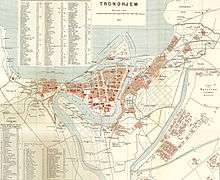
During the Second World War, Trondheim was occupied by Nazi Germany from 9 April 1940, the first day of the invasion of Norway, until the end of the war in Europe, 8 May 1945. The German invasion force consisted of the German cruiser Admiral Hipper, 4 destroyers and 1700 Austrian Mountain troops. Other than a coastal battery opening fire, there was no resistance to the invasion on 9 April at 5 AM. On 14 and 17 April, British and French forces landed near Trondheim in a failed attempt to liberate Trondheim as part of the Namsos Campaign. During the occupation, Trondheim was the home of the notorious Norwegian Gestapo agent, Henry Rinnan, who operated from a nearby villa and infiltrated Norwegian Resistance groups. The city and its citizens were also subject to harsh treatment by the occupying powers, including imposition of martial law in October 1942. During this time the Germans turned the city and its environs into a major base for submarines (which included building the large submarine base and bunker DORA I), and also contemplated a scheme to build a new city for 300,000 inhabitants, Nordstern ("Northern Star"), centred 15 kilometres (9 miles) southwest of Trondheim, near the wetlands of Øysand in the outskirts of Melhus municipality. This new metropolis was to be accompanied by a massively expanded version of the already existing naval base, which was intended to become the primary future stronghold of the German Kriegsmarine. Today, there are few physical remains of this enormous construction project.[9]
Municipal history
The city of Trondheim was established on 1 January 1838 (see formannskapsdistrikt). On 1 January 1864, part of Strinda (population: 1,229) was amalgamated with Trondheim. Then, on 1 January 1893, another part of Strinda (population: 4,097) was transferred to Trondheim. On 1 January 1952, the Lade area of Strinda (population: 2,230) was transferred to Trondheim. On 1 January 1964, a major municipal merger took place: the neighbouring municipalities of Leinstrand (population: 4,193), Byneset (population: 2,049), Strinda (population: 44,600), and Tiller (population: 3,595) were all merged with the city of Trondheim (population: 56,982), which nearly doubled the population of the municipality.[10] A transfer of Klæbu (population: 6,050) to Trondheim is planned for 1 January 2020.[11]
Coat-of-arms and seal
The coat-of-arms dates back to the 13th century. To the left, there is an archbishop with his staff and mitre in a church archway. On the right, a crowned king holding scales in a castle archway. These two pictures rest on a base which forms an arch. Underneath that arch, are three male heads which symbolise the city's rank as Norway's first capital and the archbishop's place of residence. The scales symbolise justice and the motif is based on the political philosophy of the 13th century, where the balance of power between king and church was an important issue. The three heads at the bottom may symbolise the city council. The motif is unique in Norwegian municipal heraldry, but similar motifs are found in bishopric cities on the continent. The design of the coat-of-arms that was adopted in 1897, and is still used today, was made by Håkon Thorsen.[12]
Jewish history
Jews began to settle in Trondheim in 1880, after the change of the Norwegian constitution in 1851, granting Jews permission to settle in Norway.[13] The first synagogue in Trondheim was established in 1899, and a newer one came into use by 1925. By 1900, 119 Jews were living in Trondheim, reaching 260 by 1940. The Nazi regime confiscated the synagogue in 1941, and used it for military uses. In January 1942, the town Jews' identification cards were stamped with the letter "J", and confiscations started to be more and more common. Shortly after, Jews from Trondheim began to emigrate to Sweden. The rest were sent to Auschwitz in October 1942. In 1945, after the end of the war, around 80 Jews returned to the city. Out of the 135 individuals sent to Auschwitz, only five remained in Norway. It is unclear how many others, if any, survived. The synagogue was repaired in 1947. In May 1997, a Jewish museum was opened in Trondheim. At the turn of the 21st century, 120 Jews were living in Trondheim.[13]
Geography
Trondheim is situated where the River Nidelva meets Trondheim Fjord with an excellent harbour and sheltered condition. The river used to be deep enough for most boats in the Middle Ages. An avalanche of mud and stones made it less navigable and partly ruined the harbour in the mid-17th century. The municipality's top elevation is the Storheia hill, 565 metres (1,854 ft) above sea level. At the summer solstice, the sun rises at 03:00 and sets at 23:40, but stays just below the horizon–there is no darkness (no need for artificial lighting outdoors) from 23 May to 19 July under cloud-free conditions.[14] At the winter solstice, the sun rises at 10:01, stays very low above the horizon (at midday its altitude is slightly more than 3 degrees over the horizon), and sets at 14:31.
Climate
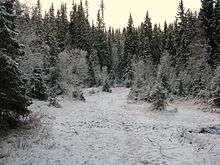
Trondheim city has a predominantly hemiboreal humid continental climate (Koppen: Dfb),[15] but closely borders on an oceanic or subpolar oceanic climate. The part of the municipality further away from the fjord has colder winters. The part close to the fjord, such as the city centre, has milder winters. Trondheim is mostly sheltered from the strong south and southwesterly winds which can occur along the outer seaboard. Trondheim experiences moderate snowfall from November to March,[16] but mixed with mild weather and rainfall. Based on the 1971–2000 average recorded at the airport, there are 14 days each winter with at least 25 cm (10 in) of snow cover on the ground and 22 days with a daily minimum temperature of −10 °C (14 °F) or less. There is often more snow and later snowmelt in suburban areas at somewhat higher elevation, such as Byåsen and Heimdal, with good skiing conditions in Bymarka. Spring often sees much sunshine, but nights can be chilly. Temperatures have tended to be warmer in recent years. The Trøndelag area has seen average temperatures increase by almost 2 °C (3.6 °F) in the last 25 years.[17]
All the monthly record lows are from 1955 or older, with half of them from before 1920. The all-time high was recorded 22 July 1901, and the all-time low in February 1899. The most exceptional record is the May record low −9.6 °C (15 °F) from 1900, 3.7 °C colder than the second coldest May night. The earliest weather stations were located closer to the city centre (Trondheim, 58 m), but from 1945 the only weather station has been located further form the centre and at a higher elevation (Voll, 127 m and Tyholt, 113 m) thus at a colder location. The lapse rate is approximately 0.6 °C (1.1 °F) per 100 m (328 ft), so the city centre will be about 0.6 °C (1.1 °F) warmer than Voll, while higher altitudes than Voll will be accordingly colder.
Three of the monthly record highs are from after 2000. From 1982 - 1996 the city had no weather stations recording temperature, so in this period Trondheim Airport is used for averages.
Temperatures have warmed in recent decades. The last overnight frost in June was in 1958, and the coldest night in May after year 2000 had low -2.7 °C.
A new sunrecorder was established by met.no in the city at Gløshaugen in late 2015, and recorded 1,592 sunhours in 2016 [18] and 1,576 sunhours in 2017. Earlier sunrecorders had blocking issues due to terrain.
| Climate data for Trondheim 1981-2010 (Voll, 127 m, extremes 1870-2018 also includes earlier stations) | |||||||||||||
|---|---|---|---|---|---|---|---|---|---|---|---|---|---|
| Month | Jan | Feb | Mar | Apr | May | Jun | Jul | Aug | Sep | Oct | Nov | Dec | Year |
| Record high °C (°F) | 13.5 (56.3) |
12.6 (54.7) |
14.6 (58.3) |
21.1 (70) |
26.9 (80.4) |
31.2 (88.2) |
35.0 (95) |
30.4 (86.7) |
26.0 (78.8) |
20.4 (68.7) |
15.4 (59.7) |
13.2 (55.8) |
35 (95) |
| Average high °C (°F) | 1.2 (34.2) |
1.5 (34.7) |
4.2 (39.6) |
8.5 (47.3) |
13.4 (56.1) |
16.2 (61.2) |
18.9 (66) |
18.0 (64.4) |
14.1 (57.4) |
9.1 (48.4) |
4.2 (39.6) |
1.7 (35.1) |
9.3 (48.7) |
| Daily mean °C (°F) | −1.9 (28.6) |
−1.6 (29.1) |
0.9 (33.6) |
4.9 (40.8) |
9.2 (48.6) |
12.5 (54.5) |
15.0 (59) |
14.2 (57.6) |
10.6 (51.1) |
6.1 (43) |
1.4 (34.5) |
−1.3 (29.7) |
5.8 (42.5) |
| Average low °C (°F) | −4.9 (23.2) |
−4.7 (23.5) |
−2.5 (27.5) |
1.1 (34) |
5.1 (41.2) |
8.5 (47.3) |
11.0 (51.8) |
10.4 (50.7) |
7.0 (44.6) |
3.0 (37.4) |
−1.3 (29.7) |
−4.3 (24.3) |
2.4 (36.3) |
| Record low °C (°F) | −25.0 (−13) |
−26.0 (−14.8) |
−22.7 (−8.9) |
−15.3 (4.5) |
−9.6 (14.7) |
−0.8 (30.6) |
0.6 (33.1) |
1.0 (33.8) |
−3.5 (25.7) |
−12.6 (9.3) |
−18.7 (−1.7) |
−24.0 (−11.2) |
−26 (−14.8) |
| Average precipitation mm (inches) | 78.2 (3.079) |
65.9 (2.594) |
56.1 (2.209) |
44.7 (1.76) |
51.9 (2.043) |
68.5 (2.697) |
88.8 (3.496) |
90.2 (3.551) |
92.1 (3.626) |
81.2 (3.197) |
73.8 (2.906) |
82.0 (3.228) |
873.4 (34.386) |
| Average precipitation days (≥ 1.0 mm) | 14 | 13 | 12 | 10 | 11 | 12 | 12 | 14 | 14 | 14 | 13 | 14 | 153 |
| Source #1: eklima.met.no[19] | |||||||||||||
| Source #2: Meteo-climat[20] | |||||||||||||
| Climate data for Trondheim Airport Værnes 1981 - 2010 (12 m, extremes 1946-present) | |||||||||||||
|---|---|---|---|---|---|---|---|---|---|---|---|---|---|
| Month | Jan | Feb | Mar | Apr | May | Jun | Jul | Aug | Sep | Oct | Nov | Dec | Year |
| Record high °C (°F) | 13.7 (56.7) |
13.8 (56.8) |
15.7 (60.3) |
22.0 (71.6) |
27.9 (82.2) |
31.7 (89.1) |
33 (91) |
31.3 (88.3) |
27.9 (82.2) |
20.9 (69.6) |
16.1 (61) |
13.1 (55.6) |
33 (91) |
| Average high °C (°F) | 1.3 (34.3) |
1.8 (35.2) |
4.4 (39.9) |
8.9 (48) |
13.9 (57) |
16.7 (62.1) |
19.4 (66.9) |
18.5 (65.3) |
14.5 (58.1) |
9.3 (48.7) |
4.3 (39.7) |
1.8 (35.2) |
9.6 (49.2) |
| Daily mean °C (°F) | −1.8 (28.8) |
−1.4 (29.5) |
1.1 (34) |
5.1 (41.2) |
9.6 (49.3) |
12.8 (55) |
15.3 (59.5) |
14.6 (58.3) |
11.0 (51.8) |
6.3 (43.3) |
1.5 (34.7) |
−1.3 (29.7) |
6.1 (42.9) |
| Average low °C (°F) | −5 (23) |
−4.5 (23.9) |
−2.3 (27.9) |
1.3 (34.3) |
5.3 (41.5) |
8.8 (47.8) |
11.2 (52.2) |
10.7 (51.3) |
7.4 (45.3) |
3.2 (37.8) |
−1.3 (29.7) |
−4.4 (24.1) |
2.5 (36.6) |
| Record low °C (°F) | −25.6 (−14.1) |
−25.5 (−13.9) |
−23.0 (−9.4) |
−13.9 (7) |
−4.7 (23.5) |
−0.2 (31.6) |
2.3 (36.1) |
−0.3 (31.5) |
−4.9 (23.2) |
−10.8 (12.6) |
−19.0 (−2.2) |
−23.5 (−10.3) |
−25.6 (−14.1) |
| Average precipitation mm (inches) | 74.7 (2.941) |
64.7 (2.547) |
54.2 (2.134) |
44.4 (1.748) |
55.3 (2.177) |
69.6 (2.74) |
87.4 (3.441) |
91.8 (3.614) |
94.1 (3.705) |
83.6 (3.291) |
69.4 (2.732) |
82.0 (3.228) |
871.2 (34.298) |
| Average precipitation days (≥ 1.0 mm) | 13 | 12 | 12 | 10 | 11 | 12 | 12 | 13 | 14 | 14 | 12 | 14 | 149 |
| Source #1: Meteo climat stats | |||||||||||||
| Source #2: eKlima/met.no | |||||||||||||

Fauna
The city has various wetland habitats. among which there is the Gaulosen. The observation tower accommodates for birdwatching and providing information about birdlife.[21]
Despite Trondheim being Norway's third largest city, wild animals can be seen. Otters and beavers thrive in Nidelva and Bymarka.[22] Badgers and foxes are not uncommon sights. Moose and deer are common in the hills surrounding the city, and might wander into the city, especially in May when the one-year-olds are chased away by their mothers, or in late winter when food grows scarce in the snow-covered higher regions. From 2002 until 2017, a wolverine lived in Bymarka.[23][24]
Cityscape and sites

Most of Trondheim city centre is scattered with small speciality shops. However, the main shopping area is concentrated around the pedestrianised streets Nordre gate (English: Northern street), Olav Tryggvasons gate and Thomas Angells gate even though the rest of the city centre is provided with everything from old, well-established companies to new, hip and trendy shops.
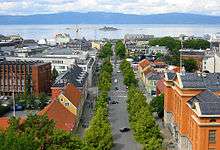
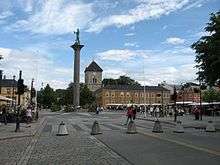
In the mid- to late 1990s, the area surrounding the old drydock and ship construction buildings of the defunct Trondhjems mekaniske Værksted shipbuilding company at the Nedre Elvehavn was renovated and old industrial buildings were torn down to make way for condominiums. A shopping centre was also built, known as Solsiden (The Sunny Side). This is a popular residential and shopping area, especially for young people.
DORA 1 is a German submarine base that housed the 13th U-boat Flotilla during the Second World War occupation of Norway. Today the bunker houses various archives, among them the city archives, the university and state archives. More recently, DORA has been used as a concert venue.
Kristiansten Fortress, built 1681–1684, is located on a hill east in Trondheim. It repelled the invading Swedes in 1718, but was decommissioned in 1816 by Crown Prince Regent Charles John.
A statue of Olav Tryggvason, the founder of Trondheim, is located in the city's central square, mounted on top of an obelisk. The statue base is also a sun dial, but it is calibrated to UTC+1 so that the reading is inaccurate by one hour in the summer.
The islet Munkholmen is a popular tourist attraction and recreation site. The islet has served as a place of execution, a monastery, a fortress, prison, and a Second World War anti-aircraft gun station.
Stiftsgården is the royal residence in Trondheim, originally constructed in 1774 by Cecilie Christine Schøller. At 140 rooms constituting 4,000 square metres (43,056 sq ft), it is possibly the largest wooden building in Northern Europe, and has been used by royals and their guests since 1800.
A statue of Leif Ericson is located at the seaside, close to the old Customs Building, the cruise ship facilities and the new swimming hall. The statue is a replica, the original being located at a Seattle marina.
Nidaros Cathedral
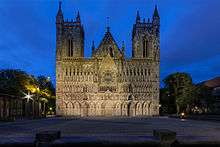
The Nidaros Cathedral and the Archbishop's Palace are located side by side in the middle of the city centre. The cathedral, built from 1070 on, is the most important Gothic monument in Norway and was Northern Europe's most important Christian pilgrimage site during the Middle Ages,[25] with pilgrimage routes leading to it from Oslo in southern Norway and from the Jämtland and Värmland regions of Sweden. Today, it is the northernmost medieval cathedral in the world, and the second largest in Scandinavia.
During the Middle Ages, and again after independence was restored in 1814, the Nidaros Cathedral was the coronation church of the Norwegian kings. King Haakon VII was the last monarch to be crowned there, in 1906. Starting with King Olav V in 1957, coronation was replaced by consecration. In 1991, the present King Harald V and Queen Sonja were consecrated in the cathedral.[26] On 24 May 2002, their daughter Princess Märtha Louise married the writer Ari Behn in the cathedral.[27]
The Pilgrim's Route (Pilegrimsleden) to the site of Saint Olufs's tomb at Nidaros Cathedral, has recently been re-instated. Also known as St. Olav's Way, (Sankt Olavs vei), the main route, which is approximately 640 kilometres (400 mi) long, starts in Oslo and heads North, along Lake Mjøsa, up the valley Gudbrandsdalen, over the mountain range Dovrefjell and down the Oppdal valley to end at Nidaros Cathedral in Trondheim. There is a Pilgrim's Office in Oslo which gives advice to pilgrims and a Pilgrim Centre in Trondheim, under the aegis of the cathedral, which awards certificates to successful pilgrims upon the completion of their journey.[28][29]
Other churches
The Lutheran Church of Norway has 21 churches within the municipality of Trondheim. They are all a part of the Diocese of Nidaros, which is based in Trondheim at the Nidaros Cathedral. Many of the churches are several hundred years old, with a couple which were built almost 1,000 years ago.
| Deanery (Prosti) | Parish (Sokn) | Church name | Year built | Location |
|---|---|---|---|---|
| Nidaros | Nidaros Domkirke og Vår Frue | Nidaros Cathedral | 1070–1300 | Midtbyen |
| Vår Frue Church | 1200 | Midtbyen | ||
| Bakklandet | Bakke Church | 1715 | Bakklandet | |
| Lade | Lade Church | 1190 | Lade | |
| Lademoen | Lademoen Church | 1905 | Lademoen | |
| Byåsen | Byåsen | Byåsen Church | 1974 | Byåsen |
| Ilen | Ilen Church | 1889 | Ila | |
| Sverresborg | Havstein Church | 1857 | Sverresborg | |
| Heimdal | Byneset | Byneset Church | 1180 | Byneset |
| Heimdal | Heimdal Church | 1960 | Heimdal | |
| Kolstad | Kolstad Church | 1986 | Kolstad | |
| Leinstrand | Leinstrand Church | 1673 | Leinstrand | |
| Tiller | Tiller Church | 1901 | Tiller | |
| Strinda | Berg | Berg Church | 1972 | Berg |
| Bratsberg | Bratsberg Church | 1850 | Bratsberg | |
| Charlottenlund | Charlottenlund Church | 1973 | Charlottenlund | |
| Hoeggen | Hoeggen Church | 1997 | Lerkendal | |
| Ranheim | Ranheim Church | 1933 | Ranheim | |
| Strinda | Strinda Church | 1900 | Strinda | |
| Strindheim | Strindheim Church | 1979 | Strindheim | |
| Tempe | Tempe Church | 1960 | Lerkendal |
The Roman Catholic Sankt Olav domkirke is the cathedral episcopal see of the exempt Territorial Prelature of Trondheim.
Museums
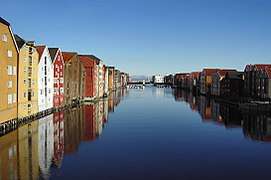
The Trondheim Museum of Arts has Norway's third largest public art collection, mainly Norwegian art from the last 150 years.[30] The National Museum of Decorative Arts boasts a large collection of decorative arts and design, including a great number of tapestries from the Norwegian tapestry artist Hannah Ryggen, as well as Norway's only permanent exhibibition of Japanese arts and crafts.[31] Sverresborg, also named Zion after King David's castle in Jerusalem, was a fortification built by Sverre Sigurdsson. It is now an open-air museum, consisting of more than 60 buildings. The castle was originally built in 1182–1183, but did not last for long as it was burned down in 1188. However, the Sverresaga indicates it had been restored by 1197.
Trondheim Science Museum (Norwegian: Vitensenteret i Trondheim) is a scientific hands-on experience center. The Museum of Natural History and Archaeology is part of the Norwegian University of Science and Technology. There are also a variety of small history, science and natural history museums, such as the Trondheim Maritime Museum, the Armoury, adjacent to the Archbishops's Palace, the music and musical instrument museum Ringve National Museum, Ringve Botanical Garden, the Trondheim Tramway Museum, and the Jewish Museum, co-located with the city's synagogue, which is among the northernmost in the world.
Rockheim (Norwegian: Det nasjonale opplevelsessenteret for pop og rock, The National Discovery Center for Pop and Rock) opened at the Pier in August 2010. It is located inside an old warehouse, but characterised by an easily recognisable roof in the shape of a box. "The box" is decorated by thousands of tiny lights that change in a variety of colours and patterns, and is a landmark in the cityscape - especially on dark winter evenings.
Government
The municipality is governed by a municipal council of elected representatives, which in turn elect a mayor.
On 1 January 2005, the city was reorganized from five boroughs into four, with each of these having separate social services offices. The current boroughs are Midtbyen (44,967 inhabitants), Østbyen (42,707 inhabitants), Lerkendal (46,603 inhabitants) and Heimdal (30,744) inhabitants. The Population statistics listed are as of 1 January 2008. Prior to 2005, Trondheim was divided into the boroughs Sentrum, Strinda, Nardo, Byåsen and Heimdal.
Municipal council
The city council (Bystyret) of Trondheim is made up of 67 representatives that are elected every four years. Prior to 2011, there were 85 city council members, but this number was reduced to 67 in 2011. Currently, the party breakdown is as follows:[32]
| Party Name | Name in Norwegian | Number of representatives | |
|---|---|---|---|
| Labour Party | Arbeiderpartiet | 28 | |
| Progress Party | Fremskrittspartiet | 4 | |
| Conservative Party | Høyre | 14 | |
| Christian Democratic Party | Kristelig Folkeparti | 2 | |
| Green Party | Miljøpartiet De Grønne | 5 | |
| Pensioners' Party | Pensjonistpartiet | 2 | |
| Red Party | Rødt | 2 | |
| Centre Party | Senterpartiet | 2 | |
| Socialist Left Party | Sosialistisk Venstreparti | 4 | |
| Liberal Party | Venstre | 4 | |
| Total number of members: | 67 | ||
2011 election
| City council elections 2011 | ||||||||
| Party | Percent | Votes | Seats in council | Members of the executive board | ||||
|---|---|---|---|---|---|---|---|---|
| % | ± | total | ± | total | ± | |||
| Labour (AP) | 39,5 | -4,4 | 35438 | 1694 | 27 | -10 | 4 | |
| Progress (FrP) | 8,9 | -5,7 | 8002 | -3255 | 6 | -7 | 1 | |
| Conservative(H) | 27,2 | 12,2 | 24367 | 12847 | 18 | +5 | 3 | |
| Christian Democrat (KrF) | 2,9 | -0,6 | 2638 | -63 | 2 | -1 | 1 | |
| Centre (SP) | 2,1 | -0,6 | 1861 | -215 | 1 | -1 | ||
| Socialist Left (SV) | 5,7 | -2,5 | 5129 | -1196 | 4 | -3 | 1 | |
| Liberal (V) | 5,8 | 1,8 | 5189 | 2087 | 4 | 1 | 1 | |
| Pensioners (PP) | 1,3 | -0,2 | 1139 | -16 | 1 | 0 | ||
| Red Party(R) | 3,0 | -0,4 | 2660 | 70 | 2 | -1 | ||
| Green Party (MDG) | 2,6 | 0,6 | 2336 | 765 | 2 | 0 | ||
| Turnout/Total | 66,7% | 89605 | 67 [A] | 11 | ||||
| Mayor: Rita Ottervik (Ap) | Deputy mayor: Knut Fagerbakke (SV) | |||||||
Comments:
Source: Ministry of Local Government Trondheim Municipality | ||||||||
Education and research
_fra_Gamle_Bybro_(main_building_of_the_Norwegian_University_of_Science_and_Technology_seen_from_the_old_city_bridge)%2C_Trondheim%2C_Norway_-_20091216.jpg)
- See also the list of primary schools in Trondheim.
Trondheim is home to both the Norwegian University of Science and Technology (NTNU) with its many technical lab facilities and disciplines, and BI-Trondheim, a satellite campus for the Norwegian Business School (BI).[33] Both universities welcome a number of international students on a yearly basis and offer various scholarships.[34]
St. Olavs University Hospital, a regional hospital for Central Norway, is located in downtown Trondheim. St. Olav's is a teaching hospital and cooperates closely with the Norwegian University of Science and Technology (NTNU) on both research and medical education.
SINTEF, the largest independent research organisation in Scandinavia, has 1,800 employees with 1,300 of these located in Trondheim.[35] The Air Force Academy of the Royal Norwegian Air Force is located at Kuhaugen in Trondheim.
The Geological Survey of Norway is located at Lade in Trondheim and is a major geoscientific institution with 220 employees of which 70% are scientists.
There are 11 high schools in the city. Trondheim katedralskole ("Trondheim Cathedral School") was founded in 1152 and is the oldest upper secondary school (gymnasium) in Norway, while Brundalen videregående skole is the largest in Sør-Trøndelag with its 1,100 students and 275 employees. Brundalen Skole, has big festivals each year, and is building out to increase space.
Ila skole was founded in 1770 and is the oldest primary school in Trondheim.[36]
Media
Adresseavisen is the largest regional newspaper and the oldest active newspaper in Norway, having been established in 1767. The two headquarters of the Norwegian Broadcasting Corporation (NRK) are located at Tyholt in Trondheim, and in Oslo.[37].
The student press of Trondheim features three types of media. Under Dusken is the student paper, Radio Revolt is the student radio, and Student-TV broadcasts videos online.
Radio stations established in Trondheim include Trøndelag-focused opt-out feeds of NRK P1 and NRK P1+, local versions of NRK Trafikk and P5 Hits, Radio Trondheim, and Radio 247[38]. Along with Norway's national radio stations, they can be listened to on DAB+ across most of Trøndelag, as well as on internet radio.
Culture
Stage
The main regional theatre, Trøndelag Teater, is situated in Trondheim. Built in 1816, the theatre is the oldest theatre still in use in Scandinavia.[39] The city also features an alternative theatre house Teaterhuset Avant Garden, and the theatre company Teater Fusentast.[40]
Music

Trondheim has a broad music scene, and is known for its strong communities committed to rock, jazz and classical music. The city's interest in Jazz and classical music are spearheaded by the music conservatory at NTNU which has been called one of the most innovative in the world,[41] and the municipal music school, Trondheim Kommunale Musikk- og Kulturskole.[42] The Trondheim Symphony Orchestra and the Trondheim Soloists are well-known. The city also hosts a yearly Jazz festival, and is home to Trondheim Jazz Orchestra.[43]
Classical artists hailing from Trondheim include violinist Arve Tellefsen, Elise Båtnes and Marianne Thorsen. Also the Nidaros Cathedral Boys' Choir.
Pop/rock artists and bands associated with Trondheim include Åge Aleksandersen, Margaret Berger, DumDum Boys, Lasse Marhaug, Gåte, Keep Of Kalessin, Lumsk, Motorpsycho, Kari Rueslåtten, the 3rd and the Mortal, TNT, Tre Små Kinesere, the Kids, Casino Steel (of the Boys), Atrox, Bloodthorn, Manes, child prodigy Malin Reitan and Aleksander With. The most popular punk scene is UFFA.
Georg Kajanus, creator of the bands Eclection, Sailor and DATA, was born in Trondheim. The music production team Stargate started out in Trondheim.
Trondheim is also home to Rockheim, the national museum of popular music, which is responsible for collecting, preserving and sharing Norwegian popular music from the 1950s to the present day.[44][45][46]
Film
Trondheim features a lively film scene, including three filmfests: Minimalen Short Film Fest and Kosmorama International Film Fest in March, and Trondheim Documentarfestival in November. There is a cinema in the city centre, Nova Kinosenter.
Sports and recreation

Granåsen, a Nordic skiing venue located in Byåsen, regularly hosts World Cup competitions in ski jumping, biathlon and cross-country skiing, as well as the 1997 FIS Nordic World Ski Championships. Trondheim attempted but failed to become the Norwegian candidate for the 2018 Winter Olympics. Hiking and recreational skiing is available around the city, particularly in Bymarka, which can be reached by the tramway. Trondheim Golfklubb has a nine-hole golf course in Byåsen.
Rosenborg BK is the city's premier football club and plays their home matches at Lerkendal Stadion. They have won the Norwegian Premier League 25 times between 1967 and 2017, have reached the UEFA Champions League group stage 12 times, and made it to the last 8 on one occasion. Byåsen IL plays in the women's handball league, and is a regular in the EHF Women's Champions League, playing their home games at Trondheim Spektrum.
Major sports teams
| Club | Sport | Founded | League | Venue |
|---|---|---|---|---|
| Rosenborg BK | Football | 1917 | Eliteserien (football) | Lerkendal stadion |
| Ranheim Fotball | Football | 1901 | Eliteserien (football) | EXTRA Arena |
| Byåsen | Handball (Women) | 1921 | Eliteserien (women's handball) | Trondheim Spektrum |
| Nidaros Hockey | Ice hockey | 2015 | 1. divisjon | Leangen Ishall |
| Trondheims-Ørn | Football (women) | 1972 | Toppserien | Ørn Arena |
| Kolstad Håndball | Handball (men) | 1972 | Eliteserien (men's handball) | Husebyhallen |
| Nidaros Jets | Basketball | 2014 | BLNO Menn | Husebyhallen |
Major championships hosted
| Event | Sport | Years | Venue |
|---|---|---|---|
| FIS Nordic World Ski Championships | Nordic skiing | 1997 | Granåsen |
| World Allround Speed Skating Championships | Speed skating | 1907, 1911, 1926, 1933, 1937 | Øya Stadion |
| World Orienteering Championships | Orienteering | 2010 | Throughout Trondheim |
| UEFA Super Cup | Football | 2016 | Lerkendal Stadion |
| European Men's Handball Championship | Handball | 2008, 2020 | Trondheim Spektrum |
| European Women's Handball Championship | Handball | 2020 | Trondheim Arena |
Student culture

With students comprising almost a fifth of the population, the city of Trondheim is heavily influenced by student culture. Most noticeable is Studentersamfundet i Trondhjem, the city's student society. Its characteristic round, red building from 1929 sits at the head of the bridge crossing the river southwards from the city centre. As the largest university in Norway, the Norwegian University of Science and Technology (NTNU) is the host of some 36,000 students.[47]
Student culture in Trondheim is characterised by a long-standing tradition of volunteer work. The student society is for example run by more than 1,200 volunteers.[48] NTNUI, Norway's largest sports club, is among the other volunteer organisations that dominate student culture in Trondheim. Students in Trondheim are also behind two major Norwegian culture festivals, UKA and The International Student Festival in Trondheim (ISFiT). NTNU lists over 200 student organisations with registered web pages on its servers alone.[49]
In popular culture
Trondheim culture is parodied on the Monty Python album Another Monty Python Record in the form of the fictitious Trondheim Hammer Dance.[50]
Trondheim is also a key location in the Command & Conquer: Tiberian Sun universe, as it is a critical battleground for both factions.
Trondheim was the name of a planet in the Hundred Worlds of the Ender's Game book series.
Transportation
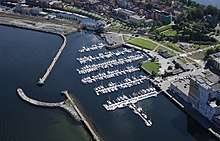
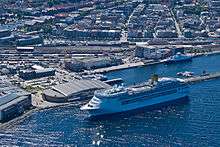
Trondheim has an international airport, Trondheim Airport, Værnes, situated in Stjørdal, which is Norway's fourth largest airport in terms of passenger traffic. Værnes has non-stop connections to cities such as London, Amsterdam, Copenhagen, Stockholm and Berlin, among others. The domestic route Trondheim - Oslo is among the busiest air routes in Europe with around 2 million passengers annually. Busiest air routes
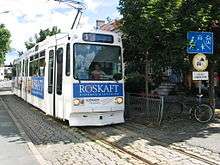
Major railway connections are the northbound Nordland Line, the eastbound Meråker Line to Åre and Östersund in Sweden, and two southbound connections to Oslo, the Røros Line and Dovre Line.
The Coastal Express ships (Hurtigruten: Covering the Bergen–Kirkenes stretch of the coast) call at Trondheim, as do many cruise ships during the summer season. Since 1994 there is also a fast commuter boat service to Kristiansund, the closest coastal city to the southwest. Every morning the Hurtigruten ships have one southbound and one northbound arrivals and departures in Trondheim.
A car ferry route from the port of Flakk in the northwest of the municipality, connects Trondheim with Fosen. Various bridge projects over the Trondheim Fjord to replace the ferry have been planned, but none have begun construction.
Trondheim also boasts the northernmost (since closure of Arkhangelsk tram in 2004) tramway line in the world: the Gråkallen Line, the last remaining segment of the Trondheim Tramway, is an 8.8 kilometres (5.5 mi) route (which is mostly single-track outside the innermost parts of the city; except the stretch between Breidablikk and Nordre Hoem stations) which runs from the city centre, through the Byåsen district, and up to Lian, in the large recreation area Bymarka. Trondheim boasts the world's only bicycle lift, Trampe.
The bus network, operated by AtB, runs throughout most of the city and its suburbs. In addition, the Nattbuss (Night Bus) service ensures cheap and effective transport for those enjoying nightlife in the city centre during the weekends. The Nattbus has other prices than ordinary buses. The European route E6 highway passes through the city centre of Trondheim in addition to a motorway bypass along the eastern rim of the city.
Twin towns and sister cities
Trondheim is twinned with:[51]
|
Notable people
- Knut Glomsaas, musician
- Johannes Høsflot Klæbo, cross-country skier
- Håkon Karlsen, journalist
- Atle Kvålsvoll, cyclist and coach
- Idun Reiten, mathematician
- Arve Tellefsen, violinist
- Diesel Dahl, drummer
- Emil Weber Meek, mixed martial artist, former welterweight champion with Venator Fighting Championship
- Merethe Trøan, singer
- Hilchen Sommerschild, educator
See also
References
- ↑ "Metropolitan_regions_of_Norway". wikipedia. Retrieved 10 June 2017.
- ↑ "Trondheim - 1601 (Sør-Trøndelag)". ssb.no/ (in Norwegian). Retrieved 10 June 2017.
- ↑ "Folkemengde og areal i tettsteder 1. januar". ssb.no/ (in Norwegian). Retrieved 23 April 2018.
- ↑ "Trondhjemmer" (in Norwegian). www.trondheim.com. Retrieved 9 January 2008.
- ↑ Statistisk sentralbyrå (2001). "Folke- og boligtellingen 2001, kommune- og bydelshefter 1601 Trondheim" (PDF) (in Norwegian).
- ↑ "Tabell 6 Folkemengde per 1. januar, etter fylke og kommune. Registrert 2010. Framskrevet 2011–2030, alternativ MMMM" (in Norwegian). Statistics Norway. Archived from the original on 22 February 2013. Retrieved 19 April 2011.
- ↑ Statistisk sentralbyrå (1 January 2013). "Urban settlements. Population and area, by municipality".
- ↑ Bratberg, Terje T. V. (10 January 2008). "Striden om bynavnet". Arbeideravisa (in Norwegian). Trondheim. p. 27.
- ↑ Hitlers drøm om Trondheim (in Norwegian)
- ↑ Jukvam, Dag (1999). "Historisk oversikt over endringer i kommune- og fylkesinndelingen" (PDF) (in Norwegian). Statistisk sentralbyrå.
- ↑ Trondheim Kommune (17 June 2016). "Ja til sammenslåing av Klæbu og Trondheim" (in Norwegian).
- ↑ "Trondheim's coat of arms and seal". Trondheim kommune. Archived from the original on 8 December 2008. Retrieved 29 October 2008.
- 1 2 "Archived copy". Archived from the original on 12 September 2014. Retrieved 11 September 2014.
- ↑ "Trondheim, Norway – Sunrise, sunset, dawn and dusk times for the whole year – Gaisma". Gaisma.com. Retrieved 1 July 2013.
- ↑ "World Weather Information Service – Trondheim". Worldweather.org. 5 October 2006. Retrieved 1 July 2013.
- ↑ "See Norway's snow, weather, water and climate anytime anywhere". Retrieved 29 December 2007.
- ↑ "Nyhet fra Meteorologisk institutt" (in Norwegian). met.no. 27 November 2007. Archived from the original on 10 December 2007.
- ↑ "Over 1600 soltimer i Bergen" (in Norwegian). årstadposten. 25 June 2017.
- ↑ "eKlima - Climate statistics for Norway from Meteorologisk Institutt (Norwegian Meteorological Institute)". January 2015.
- ↑ {{citeweb:http://meteo-climat-bzh.dyndns.org/listenormale-1981-2010-2-p159.php%7Ctitle=Moyennes | | | date =March 2017}}
- ↑ "Trondheim". ESN Trondheim. 2014-03-02. Retrieved 2017-07-14.
- ↑ "Bymarkbeveren skal holdes i sjakk" (in Norwegian). Retrieved 3 August 2007.
- ↑ "Jerven som flyktet til byen" (in Norwegian). Retrieved 9 May 2008.
- ↑ "Norges eldste jerv (18) er død" (in Norwegian). Retrieved 1 September 2017.
- ↑ "Pilgrim ways in Norway, background". Trondheim kommune. Archived from the original on 23 August 2007. Retrieved 4 August 2007.
- ↑ "The consecration of King Harald and Queen Sonja". The Norwegian Royal Family. Archived from the original on 27 September 2007. Retrieved 3 August 2007.
- ↑ "The wedding of Princess Märtha Louise". The Norwegian Royal Family. Retrieved 3 August 2007.
- ↑ "Pilegrimsleden (Miljøstatus i Norge)" (in Norwegian). Archived from the original on 17 March 2009.
- ↑ Raju, Alison (2010). The Pilgrim Road to Nidaros: St Olav's Way - Oslo to Trondheim. Cicerone Press Limited. ISBN 978-1-85284-314-4.
- ↑ Archived 7 December 2007 at the Wayback Machine.
- ↑ "Archived copy". Archived from the original on 11 June 2009. Retrieved 22 December 2009.
- ↑ "Table: 04813: Members of the local councils, by party/electoral list at the Municipal Council election (M)" (in Norwegian). Statistics Norway. 2015.
- ↑ Fossen, Christian. "Norwegian University of Science and Technology". www.ntnu.edu. Retrieved 2017-04-11.
- ↑ "Scholarships". BI Business School. Retrieved 2017-04-11.
- ↑ "About us – SINTEF". Sintef.no. 18 June 2013. Archived from the original on 12 June 2008. Retrieved 1 July 2013.
- ↑ no:Ila skole (Trondheim)
- ↑ Haugan, Trond E (2008). Byens magiske rom: Historien om Trondheim kino. Tapir Akademisk Forlag. ISBN 978-82-519-2242-5.
- ↑ "Radiokanaler på DAB". Retrieved 8 January 2018.
- ↑ Haugan, Trond E. Byens magiske rom: Historien om Trondheim kino (Tapir Akademisk Forlag, 2008, ISBN 978-82-519-2242-5) Norwegian
- ↑ "About". Teater Fusentast. Retrieved 21 May 2015.
- ↑ Nicholson, Stuart (1 May 2014). Is Jazz Dead?: Or Has It Moved to a New Address. Routledge. ISBN 1136731008.
- ↑ "History". Jazzfest. Archived from the original on 21 May 2015. Retrieved 21 May 2015.
- ↑ "Jazz Fest". Retrieved 21 May 2015.
- ↑ "Rockheim". Rockheim. Retrieved 21 May 2015.
- ↑ "Det nasjonale opplevelsessenteret for pop og rock i Trondheim vil ligge på Brattøra". Regjeringen. Retrieved 21 May 2015.
- ↑ Skybakmoen, Jonas (5 August 2010). "Rocken kommer heim". Adressa. Retrieved 21 May 2015.
- ↑ "NTNU blir størst". Khrono. Retrieved 2016-02-25.
- ↑ "About Studentersamfundet" (in Norwegian). Archived from the original on 9 November 2007. Retrieved 18 February 2008.
- ↑ "NTNU Student Organisations (in Norwegian". Retrieved 18 February 2008.
- ↑ "Apologies/ Trondheim Hammer Dance".
- 1 2 3 4 5 6 7 8 9 10 11 12 13 14 "Trondheims offisielle nettsted – Vennskapsbyer" (in Norwegian). Trondheim.com. Archived from the original on 27 September 2011. Retrieved 1 July 2013.
- ↑ "Städtepartnerschaften und Internationales". Büro für Städtepartnerschaften und internationale Beziehungen (in German). Retrieved 26 July 2013.
- ↑ "Twin Towns – Graz Online – English Version". www.graz.at. Archived from the original on 8 November 2009. Retrieved 5 January 2010.
- ↑ "Gradovi prijatelji Splita" [Split Twin Towns]. Grad Split [Split Official City Website] (in Croatian). Archived from the original on 24 March 2012. Retrieved 19 December 2013.
- ↑ (
.svg.png)
- ↑ "Vallejo Sister City". Vallejo Sister City Association. Archived from the original on 11 September 2013. Retrieved 11 September 2013.
External links
| Wikivoyage has a travel guide for Trondheim. |
| Wikimedia Commons has media related to Trondheim. |
| Wikisource has the text of the 1911 Encyclopædia Britannica article Trondhjem. |
- Municipality website (in Norwegian)
- Trondheim.no, Trondheim's official website in Norwegian and English
- Visit Trondheim

